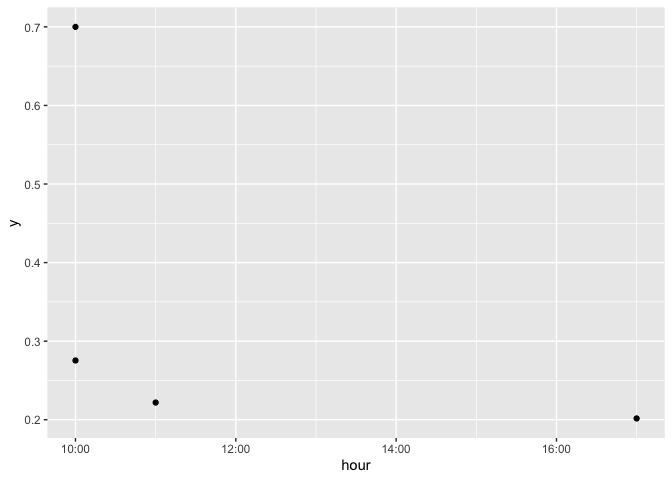Just to start, a friendly heads up that folks here generally prefer coding questions like this be asked with a reprex. That makes it much easier to replicate where you are at, and suggest ways to resolve your issue and improve the code your working with. FAQ: How to do a minimal reproducible example ( reprex ) for beginners
Some packages we'll use
library(lubridate)
library(dplyr)
library(ggplot2)
library(glue)
Setting up the data.
I used lubridate (https://lubridate.tidyverse.org/) to help with taking in those dates and times.
There's a handy function ymd_hms which will try to parse date time, assuming it has this structure.
hour is another lubridate function, which takes a date-time object and returns the hour component (there are bunch of these helper functions in lubridate, like year, months, day, etc).
df <- tibble(
started_time = c("2021-06-06 10:33:06", "2021-06-06 10:33:07", "2021-06-09 11:33:58", "2021-06-15 17:30:54")
)
df = df %>%
mutate(
y = runif(4),
datetime = ymd_hms(started_time),
hour = hour(datetime)
)
There are a few ways to create custom axis labels like this. Some discussion here, Position scales for continuous data (x & y) — scale_continuous • ggplot2
I've create a little function that takes the hour, and create a new string for it.
Glue is a handy function that helps you work with strings, for example combining variables from a tibble like this into your preferred label format, details at https://glue.tidyverse.org/
df %>%
ggplot(
aes(
x = hour,
y = y
)
) +
geom_point() +
scale_x_continuous(
labels = function(x) glue("{x}:00")
)

Created on 2022-07-21 by the reprex package (v2.0.1)